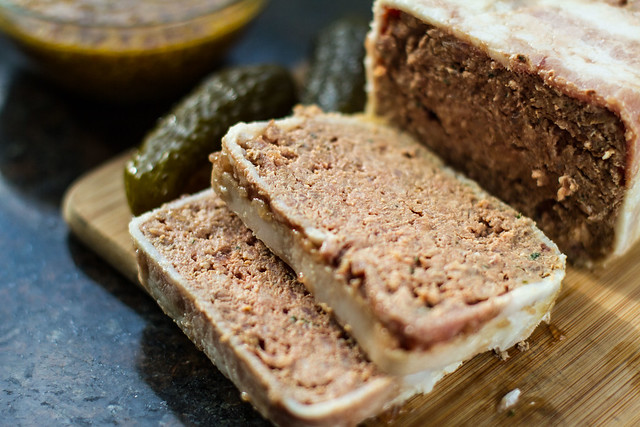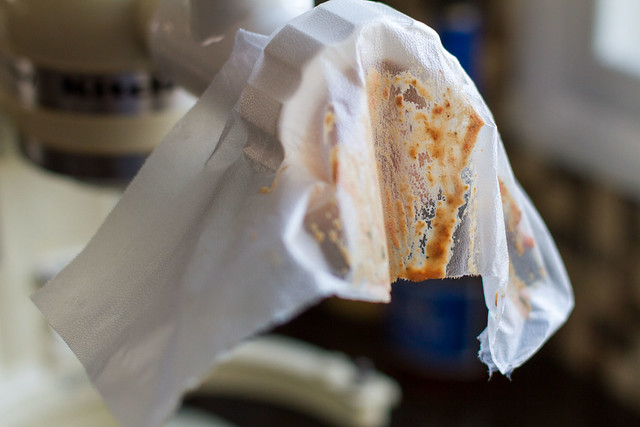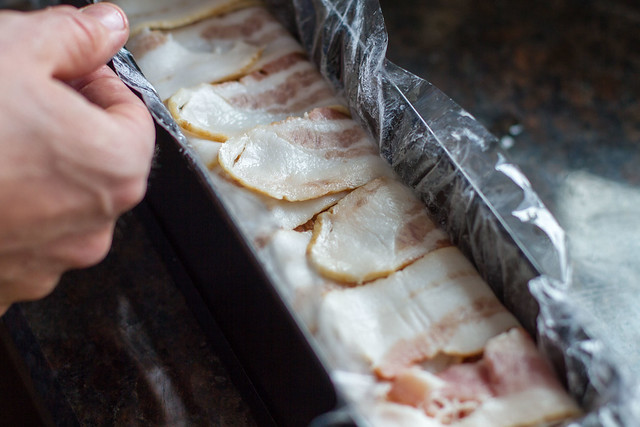Pâté Grandmère
Up front confessional. While I did cook this on the grill, it’s not really “grilled” per se. What it was, however, was fantastic. Let me explain.
I’ve had a long love affair with pâté and why shouldn’t I, a pâté, or terrine, is essentially a large sausage in a mold. It’s fat, it’s meat, it’s seasoning and it’s typically very large. Pâtés are great for entertaining and even better as a late afternoon snack, or when in hurry, a fast lunch.
Pâtés do not always mean a copious amount of liver. The first pâté I made was from John Currence’s great read, Pickles, Pigs & Whiskey. Currence had a recipe for a country style pâté with larger chunks of meat, roasted chestnuts, and a bacon wrap. It was delectable. I made it twice over Christmas…and I shared only one of them! While it had only a small amount of liver, I understand liver may be an issue for some, it’s not for me. I love it.
Pâtés are often considered “French,” even though pâtés date back to the middle ages. A few weeks ago we dined with friend’s at Dayton’s awesome Rue Dumaine. Rue Dumaine is a French focused bistro helmed by award winning Chef, and former line cook/culinary assistant for Emeril Lagasse, Anne Kearney. On the menu was a charcuterie platter and on the platter was, of course, a country style pâté. The next day I was off to the store. I had pâté on my mind and plans for it in my stomach.
While Currence’s book is fabulous, my definitive source for all things sausage, and, in this case, pâté, is the brilliant tome, Charcuterie, by Ohio native, Michael Ruhlman, and Bryan Polcyn. Charcuterie is the guide to pâté making (and also sausage making, more on that later). While it takes time and planning, pâté’s making is straightforward and relatively simple. As Ruhlman points out, pâté’s are viewed as haute cuisine and largely missing from the home kitchen. There is, however, a resurgence present in the US. I couldn’t agree more, as my kitchen has been taken over.
Keep in mind I am not writing this as an authority of all things pâté. In fact, like most things, I'm far from it. My only hope is to encourage you to pick up the torch, or in this case, the pâté mold.

Pâté Grandmère
Adapted from Charcuterie by Michael Ruhlman and Bryan Polcyn
Note: Pâté Grandmère is described as a simple, inexpensive pâté, with basic ingredients. It also happens to contain a lot of liver. For the non-liver lovers, suck it up. It’s worth it.
1 1/4 pounds chicken liver
1 pound boneless pork shoulder, diced
1 ounce kosher salt (weight vs. volume, it’s all about the weight)
1 t freshly ground pepper
2 bay leaves
2 sprigs fresh thyme
2 T vegetable oil
1/4 cup chopped shallots
2 T brandy
2 slices white bread, no crusts, chopped
1/2 cup whole milk
1/4 cup heavy cream
2 large eggs
1 T chopped fresh flat-leaf parsley
1/4 t ground white pepper
1/4 t freshly grated nutmeg
1. In one bowl, mix together the liver, 1 bay leaf, 1 thyme sprig, and half the salt and pepper. In other bowl, mix together the pork, the remaining salt and pepper, bay leaf, and thyme. Cover each bowl and refrigerate over night.
2. They key to working with emulsified meat is cold temperatures. Likewise, Ruhlman suggests freezing the grinder, die, blades and bowls. Currence states the opposite believing frozen metal is a recipe for disaster. I split the baby. I placed the bowl and blade mixer in the freezer. I left the smaller grinder pieces out.
3. In a large fry pan, heat the oil until just smoking. Add the liver (minus the thyme and bay leaves) and sauté to develop a crust. Remove from the pan, place on a tray and refrigerate.

4. Add the shallots to the pan and sauté until translucent, add the brandy to deglaze. Allow the brandy to cook mostly off and then add the still moist shallots to a bowl.
5. Sure, you could use the oven, but this is a blog about the grill, so prep the grill for indirect medium-low heat, 300 F.
6. Mix together the bread, milk, cream, and eggs in a bowl.

7. Remove the bay leaf and thyme from the pork.

Add the chilled liver, milk mixture, and parsley to the pork bowl.

Grind through a mixer using a small die.

Be sure to place the stand mixer bowl in a bowl of ice to keep the meat cold.

Note: This can be a real messy grind, so I find a “grinding shield” a nice addition in keeping meat off the walls and in the bowl. As usual, I only know this because I’ve done it!

8. With the mixer’s paddle, mix the grind on medium speed until it begins to look sticky, which takes about a minute.

9. Fry up a small amount of the meat and test for seasoning.
10. With plastic wrap, line the inside of a terrine mold.

Note: Any type of terrine mold will work, but here is what I used.
Use enough plastic wrap so you can cover the top of the mold when done.
11. Place bacon strips, side by side, down the length of the terrine.

Pack the terrine with meat and then cover with the bacon strips followed by the plastic wrap.


Be sure the meat is packed tightly to reduce air pockets. Cover the terrine top with aluminum foil.
12. Place the terrine in a high-sided roasting pan and then fill the roasting pan with very hot tap water. Allow the water to come halfway up the sides of the terrine.

13. Close the lid on the grill and cook until the terrine reaches an internal temperature of 160 F.

14. Remove the terrine from the water, place a weight across the top of the meat, and allow to cool to room temperature. Refrigerate overnight.

While pâté is great for entertaining, probably my favorite thing to do is come home from work, cut off a slice and enjoy it with fresh crisp pickles and spicy sweet mustard. It’s rich, filling, and totally divine. If you are seriously interested in pâté (and sausage) Charcuterie is highly recommended!
